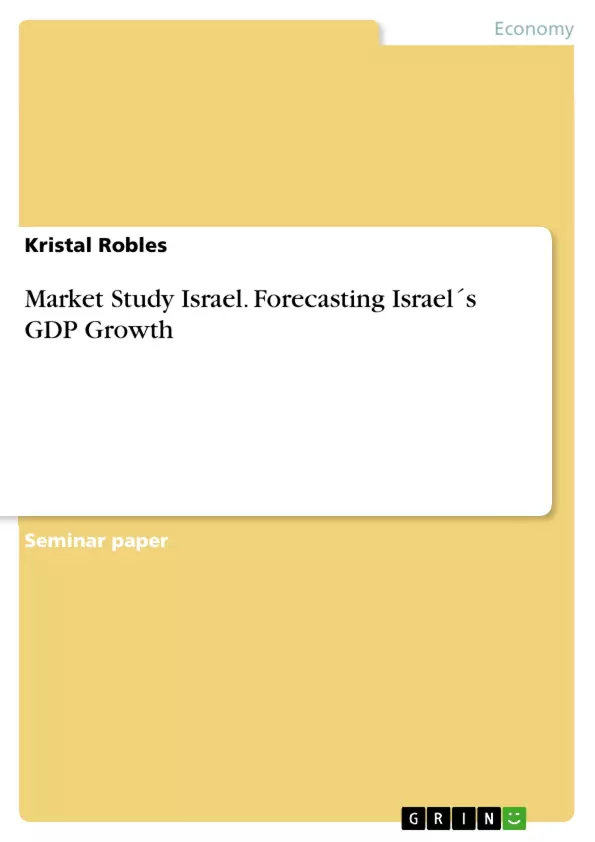The purpose of this seminar paper is to determine Israel’s current economic situation, the economic outlook for the next two years and the mains risks the country is exposed to.
In this paper we evaluate Israel’s current real Gross Domestic Products (GDP) growth rate, current and lagging indicators influencing the GDP growth rate and different forecast models with input sample real GDP data. Finally the model with the best performance to forecast Israel’s real GDP growth will be applied, providing a forecast for the next two fiscal years.
Inhaltsverzeichnis (Table of Contents)
- Summary
- Introduction
- Israel's Real GDP
- Data
- Oil Price
- Business Cycle
- Leading or lagging Indicators
- Forecast assumptions
- Exchange Rate
- Business cycle US
- Business Cycle forecast
- Introduction
- Our approach
- Methodology
- Evaluation Results
- Final Forecast
- Forecast Values and forecast Comparison
- Conclusion
- Risk analyisis
- Biblography
Zielsetzung und Themenschwerpunkte (Objectives and Key Themes)
This seminar paper aims to analyze Israel's current economic situation, forecast its economic outlook for the next two years, and identify the main risks it faces. It assesses Israel's current real GDP growth rate, examines indicators influencing GDP growth, and evaluates different forecast models using real GDP data. The paper culminates in a forecast for the next two fiscal years using the best-performing model.
- Evaluation of Israel's current real GDP growth rate
- Analysis of indicators influencing GDP growth (leading and lagging)
- Assessment of different forecast models for Israel's real GDP
- Development and application of a forecast model for the next two fiscal years
- Identification of key economic risks facing Israel
Zusammenfassung der Kapitel (Chapter Summaries)
- Chapter 1 provides a brief overview of Israel's economy, highlighting its historical context and current characteristics.
- Chapter 2 focuses on evaluating the current business cycle by extracting the trend (potential GDP) from the real GDP data using the Hodrick-Prescott (HP) filtering method. This analysis considers the influence of oil prices and leading/lagging indicators on the business cycle.
- Chapter 3 explores exogenous parameters and their assumptions, which serve as a basis for the forecast that will be conducted in Chapter 4.
- Chapter 4 presents the forecast methodology, utilizing quarterly real GDP data from Q1/1995 to Q4/2015. This chapter compares different forecasting models using time series analysis and autoregressive approaches, evaluating their performance against real GDP data. The chapter concludes with the chosen model's forecast for the next two fiscal years.
Schlüsselwörter (Keywords)
This seminar paper focuses on Israel's economic situation, specifically its real GDP growth, business cycle analysis, and forecasting methods. The key concepts include GDP, leading and lagging indicators, HP filtering, time series analysis, autoregressive models, and risk analysis. The paper aims to provide a comprehensive understanding of Israel's economic outlook and its potential vulnerabilities.
- Arbeit zitieren
- Kristal Robles (Autor:in), 2016, Market Study Israel. Forecasting Israel´s GDP Growth, München, GRIN Verlag, https://www.grin.com/document/371826



